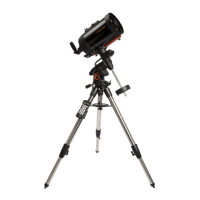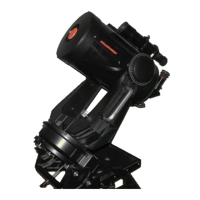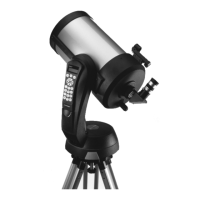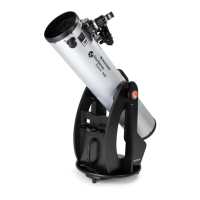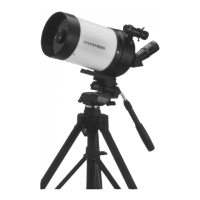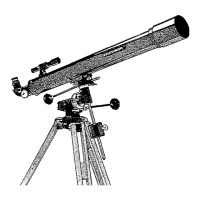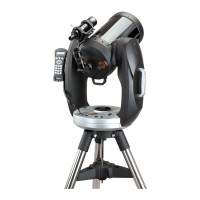Do you have a question about the Celestron Celestar 8 and is the answer not in the manual?
Guidance on navigating the manual and its sections for proper telescope operation.
Important safety warnings to ensure user safety and protect equipment.
Explanation of the telescope's unique optical design and its components.
Instructions for carefully removing and checking telescope components after unboxing.
Step-by-step guide to properly assemble and stabilize the telescope's tripod.
Procedure for securely mounting the telescope's wedge onto the tripod.
Steps for mounting the finder scope and its bracket to the telescope.
Instructions for attaching components like the visual back, star diagonal, and eyepieces.
How to point and maneuver the telescope using its R.A. and DEC controls.
Understanding how the image appears based on accessory use and orientation.
Explanation of the focusing mechanism and how to achieve a sharp image.
Step-by-step process to align the finder scope with the main telescope optics.
Guidance for initial observations, including daytime and nighttime setup.
Formula and explanation for determining telescope magnification with different eyepieces.
Tips for optimal visual observation, including environmental factors.
Explanation of the celestial coordinate system (RA and DEC) used for locating objects.
Description of how stars appear to move in the sky due to Earth's rotation.
The process of aligning the telescope's axis with Earth's rotational axis for tracking.
A method for polar alignment using the telescope's latitude scale.
Procedure to align the Right Ascension setting circle for accurate object location.
Instructions on how to turn on and power the telescope's drive motor.
How to configure the drive for use in the Southern Hemisphere.
Common issues and solutions for the Celestron drive system.
Steps to power up the Celestar Deluxe drive system using batteries or external power.
How to select different tracking rates (sidereal, solar, lunar, King).
Explanation and usage of the PEC feature to improve tracking accuracy.
How to adjust dip switches for Southern Hemisphere operation on the Deluxe model.
Guidance on observing the Moon, including optimal phases and filter use.
Information on observing planets like Venus, Mars, Jupiter, and Saturn.
Precautions and methods for safely observing the Sun.
Information on observing objects beyond the solar system, like nebulae and galaxies.
A method for locating celestial objects by navigating between bright stars.
Factors affecting image quality, including transparency, sky illumination, and seeing.
Introduction to photographing celestial objects directly through the telescope.
Technique for photographing constellations using a camera mounted on the telescope.
Advanced technique for photographing deep-sky objects requiring long exposure times.
Using the Fastar lens assembly for high-speed CCD imaging at f/1.95.
Explanation of f-numbers and their effect on imaging performance.
Details on imaging at f/1.95, including exposure times and suitable objects.
Guide to imaging medium and small galaxies at f/6.3.
Instructions for cleaning the telescope's corrector plate and optical surfaces.
The process of aligning the telescope's mirrors for optimal optical performance.
Procedure for obtaining authorization before returning products for warranty service.
Warranty terms for Celestron accessories and electronic components.
Details regarding product repair, replacement, and warranty void conditions.
Guidance on navigating the manual and its sections for proper telescope operation.
Important safety warnings to ensure user safety and protect equipment.
Explanation of the telescope's unique optical design and its components.
Instructions for carefully removing and checking telescope components after unboxing.
Step-by-step guide to properly assemble and stabilize the telescope's tripod.
Procedure for securely mounting the telescope's wedge onto the tripod.
Steps for mounting the finder scope and its bracket to the telescope.
Instructions for attaching components like the visual back, star diagonal, and eyepieces.
How to point and maneuver the telescope using its R.A. and DEC controls.
Understanding how the image appears based on accessory use and orientation.
Explanation of the focusing mechanism and how to achieve a sharp image.
Step-by-step process to align the finder scope with the main telescope optics.
Guidance for initial observations, including daytime and nighttime setup.
Formula and explanation for determining telescope magnification with different eyepieces.
Tips for optimal visual observation, including environmental factors.
Explanation of the celestial coordinate system (RA and DEC) used for locating objects.
Description of how stars appear to move in the sky due to Earth's rotation.
The process of aligning the telescope's axis with Earth's rotational axis for tracking.
A method for polar alignment using the telescope's latitude scale.
Procedure to align the Right Ascension setting circle for accurate object location.
Instructions on how to turn on and power the telescope's drive motor.
How to configure the drive for use in the Southern Hemisphere.
Common issues and solutions for the Celestron drive system.
Steps to power up the Celestar Deluxe drive system using batteries or external power.
How to select different tracking rates (sidereal, solar, lunar, King).
Explanation and usage of the PEC feature to improve tracking accuracy.
How to adjust dip switches for Southern Hemisphere operation on the Deluxe model.
Guidance on observing the Moon, including optimal phases and filter use.
Information on observing planets like Venus, Mars, Jupiter, and Saturn.
Precautions and methods for safely observing the Sun.
Information on observing objects beyond the solar system, like nebulae and galaxies.
A method for locating celestial objects by navigating between bright stars.
Factors affecting image quality, including transparency, sky illumination, and seeing.
Introduction to photographing celestial objects directly through the telescope.
Technique for photographing constellations using a camera mounted on the telescope.
Advanced technique for photographing deep-sky objects requiring long exposure times.
Using the Fastar lens assembly for high-speed CCD imaging at f/1.95.
Explanation of f-numbers and their effect on imaging performance.
Details on imaging at f/1.95, including exposure times and suitable objects.
Guide to imaging medium and small galaxies at f/6.3.
Instructions for cleaning the telescope's corrector plate and optical surfaces.
The process of aligning the telescope's mirrors for optimal optical performance.
Procedure for obtaining authorization before returning products for warranty service.
Warranty terms for Celestron accessories and electronic components.
Details regarding product repair, replacement, and warranty void conditions.
